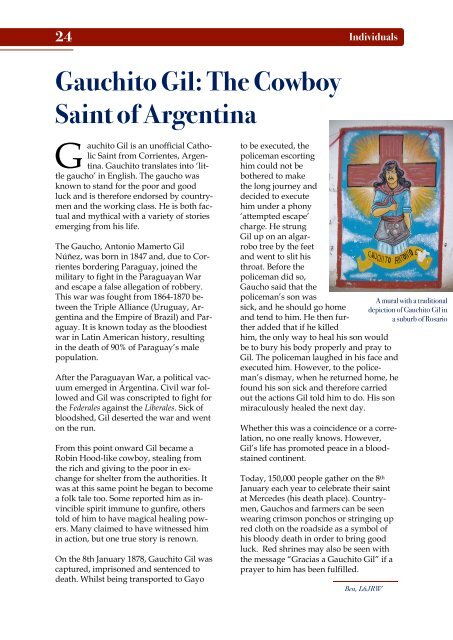Create successful ePaper yourself
Turn your PDF publications into a flip-book with our unique Google optimized e-Paper software.
24 Individuals<br />
Gauchito Gil: <strong>The</strong> Cowboy<br />
Saint of Argentina<br />
G<br />
auchito Gil is an unofficial Catholic<br />
Saint from Corrientes, Argentina.<br />
Gauchito translates into ‘little<br />
gaucho’ in English. <strong>The</strong> gaucho was<br />
known to stand for the poor and good<br />
luck and is therefore endorsed by countrymen<br />
and the working class. He is both factual<br />
and mythical with a variety of stories<br />
emerging from his life.<br />
<strong>The</strong> Gaucho, Antonio Mamerto Gil<br />
Núñez, was born in 1847 and, due to Corrientes<br />
bordering Paraguay, joined the<br />
military to fight in the Paraguayan War<br />
and escape a false allegation of robbery.<br />
This war was fought from 1864-1870 between<br />
the Triple Alliance (Uruguay, Argentina<br />
and the Empire of Brazil) and Paraguay.<br />
It is known today as the bloodiest<br />
war in Latin American history, resulting<br />
in the death of 90% of Paraguay’s male<br />
population.<br />
After the Paraguayan War, a political vacuum<br />
emerged in Argentina. Civil war followed<br />
and Gil was conscripted to fight for<br />
the Federales against the Liberales. Sick of<br />
bloodshed, Gil deserted the war and went<br />
on the run.<br />
From this point onward Gil became a<br />
Robin Hood-like cowboy, stealing from<br />
the rich and giving to the poor in exchange<br />
for shelter from the authorities. It<br />
was at this same point he began to become<br />
a folk tale too. Some reported him as invincible<br />
spirit immune to gunfire, others<br />
told of him to have magical healing powers.<br />
Many claimed to have witnessed him<br />
in action, but one true story is renown.<br />
On the 8th January 1878, Gauchito Gil was<br />
captured, imprisoned and sentenced to<br />
death. Whilst being transported to Gayo<br />
to be executed, the<br />
policeman escorting<br />
him could not be<br />
bothered to make<br />
the long journey and<br />
decided to execute<br />
him under a phony<br />
‘attempted escape’<br />
charge. He strung<br />
Gil up on an algarrobo<br />
tree by the feet<br />
and went to slit his<br />
throat. Before the<br />
policeman did so,<br />
Gaucho said that the<br />
policeman’s son was<br />
A mural with a traditional<br />
sick, and he should go home depiction of Gauchito Gil in<br />
and tend to him. He then further<br />
added that if he killed<br />
a suburb of Rosario<br />
him, the only way to heal his son would<br />
be to bury his body properly and pray to<br />
Gil. <strong>The</strong> policeman laughed in his face and<br />
executed him. However, to the policeman’s<br />
dismay, when he returned home, he<br />
found his son sick and therefore carried<br />
out the actions Gil told him to do. His son<br />
miraculously healed the next day.<br />
Whether this was a coincidence or a correlation,<br />
no one really knows. However,<br />
Gil’s life has promoted peace in a bloodstained<br />
continent.<br />
Today, 150,000 people gather on the 8 th<br />
January each year to celebrate their saint<br />
at Mercedes (his death place). Countrymen,<br />
Gauchos and farmers can be seen<br />
wearing crimson ponchos or stringing up<br />
red cloth on the roadside as a symbol of<br />
his bloody death in order to bring good<br />
luck. Red shrines may also be seen with<br />
the message “Gracias a Gauchito Gil” if a<br />
prayer to him has been fulfilled.<br />
Ben, L6JRW


















